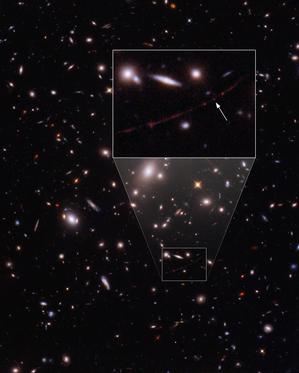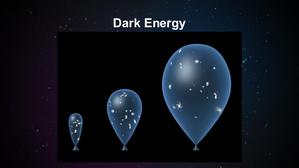Glossary term: गुरुत्वीय भिंग (ग्रॅव्हिटेशनल लेन्सिंग)
Description: वस्तुमान असलेल्या वस्तू त्यांच्या गुरुत्वाकर्षणाच्या प्रभावाजवळून जाणार्या प्रकाशाच्या मार्गाला वाकवू शकतात. आइन्स्टाईनच्या सामान्य सापेक्षतेने भाकीत केलेला हा परिणाम १९१९ च्या सूर्यग्रहणाच्या वेळी पहिल्यांदा दिसला जेव्हा सूर्याजवळील अनेक तार्यांचे वाकणे मोजले गेले. ग्रॅव्हिटेशनल लेन्सिंग हे आकाशगंगा किंवा क्लस्टर्स (आकाशगंगांचा समूह) सारख्या खूप मोठ्या वस्तूंसाठी सर्वात स्पष्ट दिसते. जर पृथ्वीवरील निरीक्षक एखाद्या दूरच्या वस्तूकडे पहात असतील तर ज्याचा प्रकाश अशा प्रकारे वाकलेला असेल ("लेन्स" द्वारे), की ती वस्तू विकृत दिसेल. ही विकृती नेहमी प्रकाशाचे विकृतीकरण सूचित करते, ज्यामुळे सामान्यत: पार्श्वभूमीतील अस्पष्ट वस्तू आपल्याला अधिक चांगल्या प्रकारे पाहता येतात. हेच लेन्सच्या लहान कोनीय क्षेत्रात पुरेसे वस्तुमान केंद्रित होते, तेव्हा पार्श्वभूमीवर असणाऱ्या एकाच वस्तूच्या अनेक प्रतिमा तयार होतात, ज्यामध्ये प्रत्येक प्रतिमेसाठीचा प्रकाश वेगवेगळ्या वेळी निरीक्षकापर्यंत पोहोचतो. हाच "वेळ विलंब" मोजणे हा एक्स्ट्रागॅलेक्टिक स्केलवर हबल कॉन्स्टंटचे मूल्य निर्धारित करण्याचा एक उत्तम मार्ग आहे. तसेच लेन्समधील अनेक प्रतिमा पाहून आणि त्याच्या नमुना किव्वा प्रतिकृतीच्या (मॉडेल्सचा) अभ्यास करून, आपल्याला त्या वास्तूचे वस्तुमान अचूकपणे निर्धारित करण्यास मदत होते. आकाशगंगांसाठी असे करण्यासाठी ही एक अतिशय उपयुक्त पद्धत आहे, तर आकाशगंगा क्लस्टर्ससाठी हि पध्दत अधिक उपयोगी आहे.
Related Terms:
See this term in other languages
Term and definition status: The original definition of this term in English have been approved by a research astronomer and a teacher The translation of this term and its definition is still awaiting approval
The OAE Multilingual Glossary is a project of the IAU Office of Astronomy for Education (OAE) in collaboration with the IAU Office of Astronomy Outreach (OAO). The terms and definitions were chosen, written and reviewed by a collective effort from the OAE, the OAE Centers and Nodes, the OAE National Astronomy Education Coordinators (NAECs) and other volunteers. You can find a full list of credits here. All glossary terms and their definitions are released under a Creative Commons CC BY-4.0 license and should be credited to "IAU OAE".
If you notice a factual or translation error in this glossary term or definition then please get in touch.
Related Media
A gravitational lens magnifies one of the first stars
Credit: NASA, ESA, B. Welch (JHU), D. Coe (STScI), A. Pagan (STScI) credit link
License: CC-BY-4.0 Creative Commons Attribution 4.0 International (CC BY 4.0) icons
Related Activities
Dark matter & dark energy (Part 2) – Understanding the nature of dark matter and dark energy
astroEDU educational activity (links to astroEDU website) Description: Let's investigate the nature of dark matter and energy with gravitational lensing!
License: CC-BY-4.0 Creative Commons Attribution 4.0 International (CC BY 4.0) icons
Tags:
Experiment
, Invisible
Age Ranges:
12-14
, 14-16
, 16-19
, 19+
Education Level:
Informal
, Middle School
Areas of Learning:
Guided-discovery learning
, Interactive Lecture
, Modelling
, Problem-solving
Costs:
Medium Cost
Duration:
45 mins
Group Size:
Group
Skills:
Constructing explanations
, Developing and using models
, Engaging in argument from evidence










